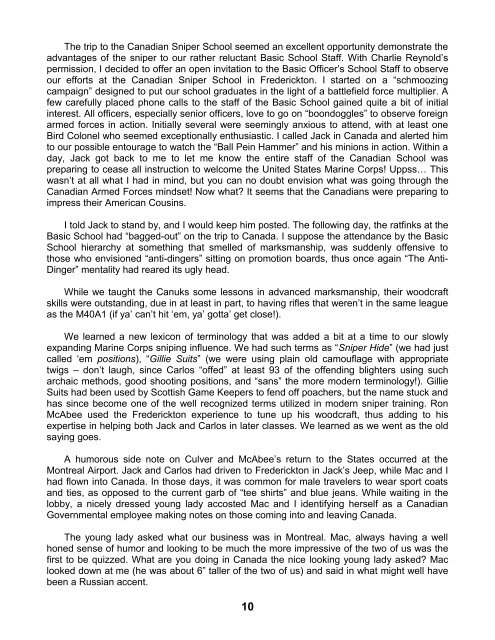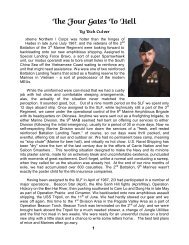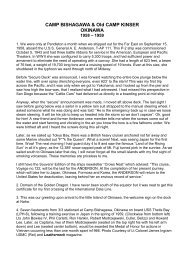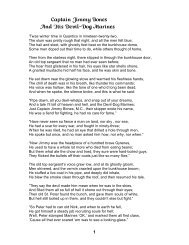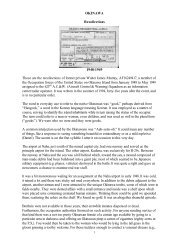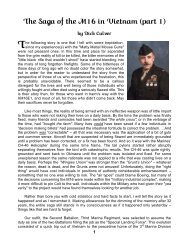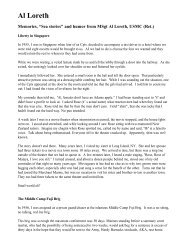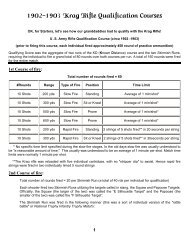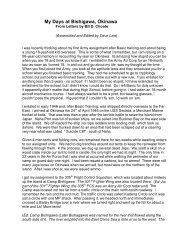History of the USMC Sniper School - Rohrer, Bob Rohrer
History of the USMC Sniper School - Rohrer, Bob Rohrer
History of the USMC Sniper School - Rohrer, Bob Rohrer
Create successful ePaper yourself
Turn your PDF publications into a flip-book with our unique Google optimized e-Paper software.
The trip to <strong>the</strong> Canadian <strong>Sniper</strong> <strong>School</strong> seemed an excellent opportunity demonstrate <strong>the</strong><br />
advantages <strong>of</strong> <strong>the</strong> sniper to our ra<strong>the</strong>r reluctant Basic <strong>School</strong> Staff. With Charlie Reynold’s<br />
permission, I decided to <strong>of</strong>fer an open invitation to <strong>the</strong> Basic Officer’s <strong>School</strong> Staff to observe<br />
our efforts at <strong>the</strong> Canadian <strong>Sniper</strong> <strong>School</strong> in Frederickton. I started on a “schmoozing<br />
campaign” designed to put our school graduates in <strong>the</strong> light <strong>of</strong> a battlefield force multiplier. A<br />
few carefully placed phone calls to <strong>the</strong> staff <strong>of</strong> <strong>the</strong> Basic <strong>School</strong> gained quite a bit <strong>of</strong> initial<br />
interest. All <strong>of</strong>ficers, especially senior <strong>of</strong>ficers, love to go on “boondoggles” to observe foreign<br />
armed forces in action. Initially several were seemingly anxious to attend, with at least one<br />
Bird Colonel who seemed exceptionally enthusiastic. I called Jack in Canada and alerted him<br />
to our possible entourage to watch <strong>the</strong> “Ball Pein Hammer” and his minions in action. Within a<br />
day, Jack got back to me to let me know <strong>the</strong> entire staff <strong>of</strong> <strong>the</strong> Canadian <strong>School</strong> was<br />
preparing to cease all instruction to welcome <strong>the</strong> United States Marine Corps! Uppss… This<br />
wasn’t at all what I had in mind, but you can no doubt envision what was going through <strong>the</strong><br />
Canadian Armed Forces mindset! Now what? It seems that <strong>the</strong> Canadians were preparing to<br />
impress <strong>the</strong>ir American Cousins.<br />
I told Jack to stand by, and I would keep him posted. The following day, <strong>the</strong> ratfinks at <strong>the</strong><br />
Basic <strong>School</strong> had “bagged-out” on <strong>the</strong> trip to Canada. I suppose <strong>the</strong> attendance by <strong>the</strong> Basic<br />
<strong>School</strong> hierarchy at something that smelled <strong>of</strong> marksmanship, was suddenly <strong>of</strong>fensive to<br />
those who envisioned “anti-dingers” sitting on promotion boards, thus once again “The Anti-<br />
Dinger” mentality had reared its ugly head.<br />
While we taught <strong>the</strong> Canuks some lessons in advanced marksmanship, <strong>the</strong>ir woodcraft<br />
skills were outstanding, due in at least in part, to having rifles that weren’t in <strong>the</strong> same league<br />
as <strong>the</strong> M40A1 (if ya’ can’t hit ‘em, ya’ gotta’ get close!).<br />
We learned a new lexicon <strong>of</strong> terminology that was added a bit at a time to our slowly<br />
expanding Marine Corps sniping influence. We had such terms as “<strong>Sniper</strong> Hide” (we had just<br />
called ‘em positions), “Gillie Suits” (we were using plain old camouflage with appropriate<br />
twigs – don’t laugh, since Carlos “<strong>of</strong>fed” at least 93 <strong>of</strong> <strong>the</strong> <strong>of</strong>fending blighters using such<br />
archaic methods, good shooting positions, and “sans” <strong>the</strong> more modern terminology!). Gillie<br />
Suits had been used by Scottish Game Keepers to fend <strong>of</strong>f poachers, but <strong>the</strong> name stuck and<br />
has since become one <strong>of</strong> <strong>the</strong> well recognized terms utilized in modern sniper training. Ron<br />
McAbee used <strong>the</strong> Frederickton experience to tune up his woodcraft, thus adding to his<br />
expertise in helping both Jack and Carlos in later classes. We learned as we went as <strong>the</strong> old<br />
saying goes.<br />
A humorous side note on Culver and McAbee’s return to <strong>the</strong> States occurred at <strong>the</strong><br />
Montreal Airport. Jack and Carlos had driven to Frederickton in Jack’s Jeep, while Mac and I<br />
had flown into Canada. In those days, it was common for male travelers to wear sport coats<br />
and ties, as opposed to <strong>the</strong> current garb <strong>of</strong> “tee shirts” and blue jeans. While waiting in <strong>the</strong><br />
lobby, a nicely dressed young lady accosted Mac and I identifying herself as a Canadian<br />
Governmental employee making notes on those coming into and leaving Canada.<br />
The young lady asked what our business was in Montreal. Mac, always having a well<br />
honed sense <strong>of</strong> humor and looking to be much <strong>the</strong> more impressive <strong>of</strong> <strong>the</strong> two <strong>of</strong> us was <strong>the</strong><br />
first to be quizzed. What are you doing in Canada <strong>the</strong> nice looking young lady asked? Mac<br />
looked down at me (he was about 6” taller <strong>of</strong> <strong>the</strong> two <strong>of</strong> us) and said in what might well have<br />
been a Russian accent.<br />
10


